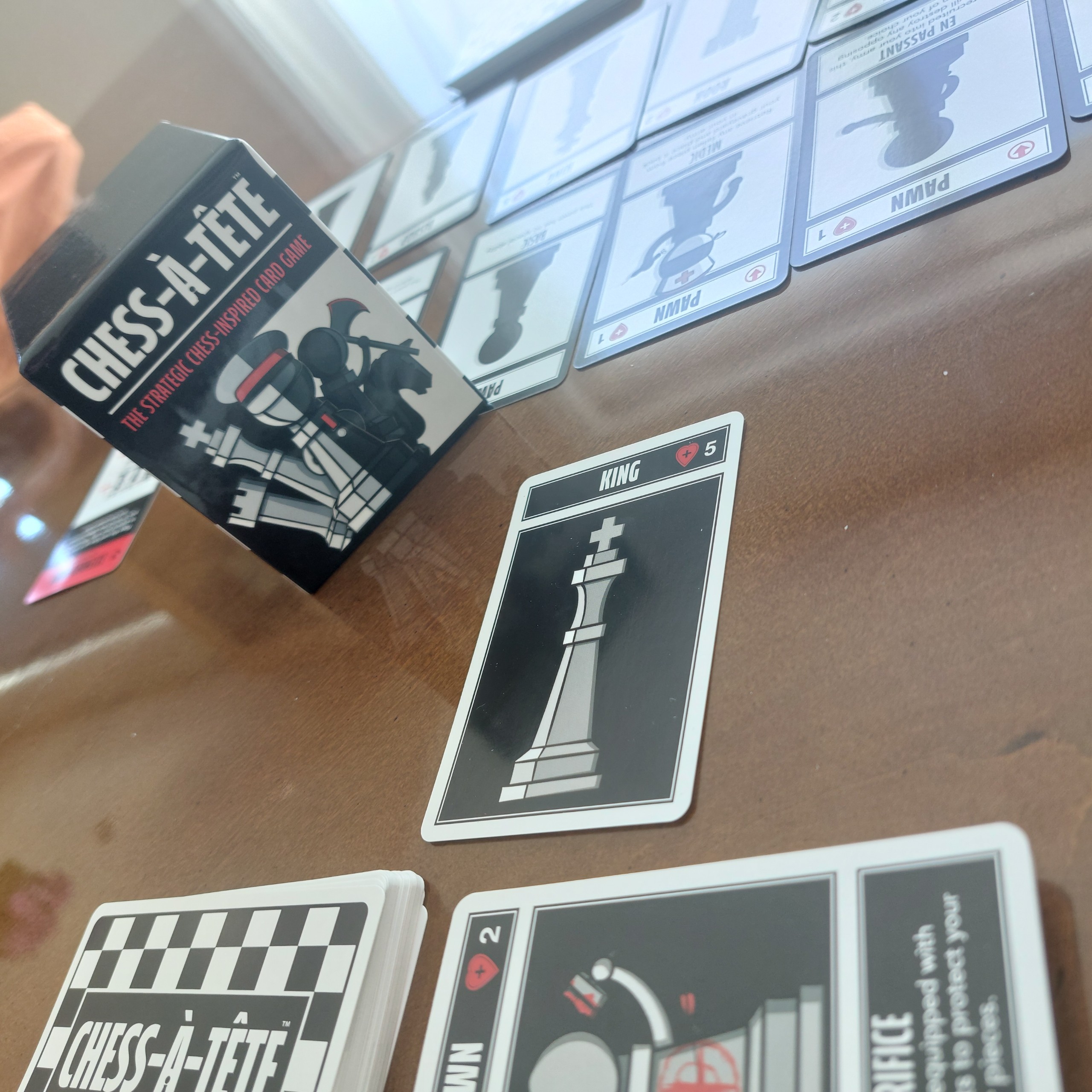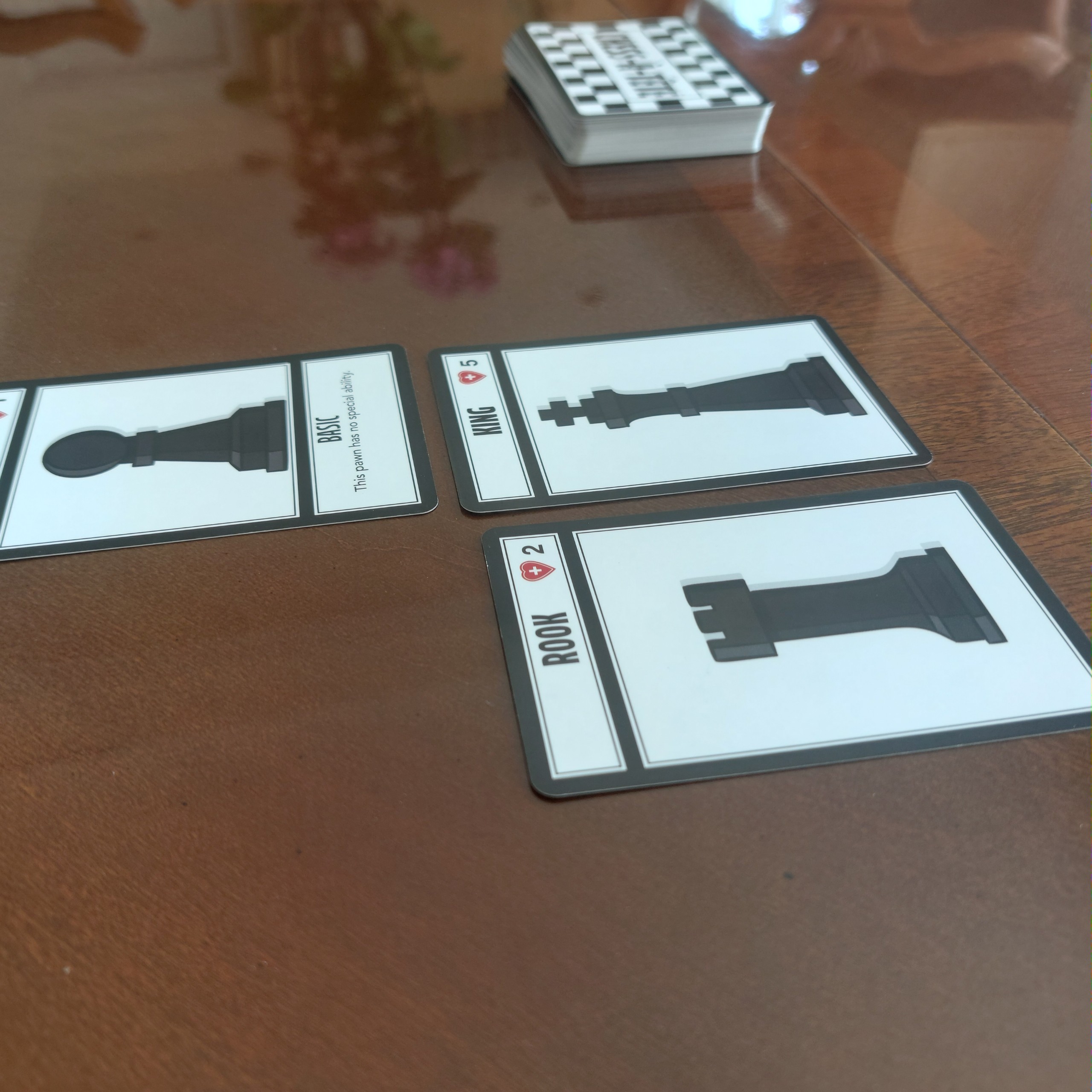Chess-a-tete is a two player essentially built around Chess, but it’s not, if that makes sense. Fundamentally if you’ve played Chess, you’ll instantly recognise the pieces and it’ll feel familiar, but equally it won’t. The aim of Chess-a-tete is to capture your eliminate your opponents King or lay a complete army and then play your checkmate card. Or if you run out of cards in your draw deck, you lose!

At the start of the game, each player will pick their deck colour and places their king in front of them. Shuffles their deck and draws seven cards and as per Chess rules, white goes first.

Chess-a-tete is played over a number of turns back and forth between the two players until someone is victorious! On your turn you can play upto three cards, or optionally you can burn cards by sending them to the graveyard (I smell a magic the gathering similarity!) and then drawing that many cards. After your turn you draw back upto seven.

The cards are broken down into:
Army pieces (consisting of pawns and power pieces)
Action cards
Attack/defend cards
Checkmate card

One card you can play is army pieces, allowing you to add pieces to your army, and like Chess you are limited to two knights, rooks, bishops and a queen. Unless you play the extended battlefield card, which will allow you to play additional army pieces. Pawns are of course the cannon fodder and the front line of your defences, but unlike actual Chess, pawns in Chess-a-tete often have unique abilities. And every piece has a hit point value, which matters when it comes to attacking and defending.

Action cards are often a reaction, and generally require you to have certain pieces in your army to be able to play and resolve them. Whilst you can only play one attack card per turn, these are the crux of the game and ultimately your path to victory, although attack cards are also defend cards, so you’ll need to balance playing attack cards and then keeping some attack cards to use them for their defense ability.

To play an attack card, you need to have the pieces if your army as specified on the card. Your opponent then has the opportunity to play a defense card, and they must play a defense card if they can. I’m not sure on the must, but it works, i guess its to prevent intentional sacrifice of pieces? Afterwhich, you compare attack and defense values, with a stalemate meaning everyone loses all their mobilised pieces and attack and defend cards. When a player loses, they lose hit points equal to the power value on the attack or defend card, each unit has a hit point value and the total hit point value discarded must equal or be greater than the power value. Meaning if you’ve only got super strong units and lose a battle, you could find yourself losing those vital pieces of your army as you forgot your cannon fodder! But herein lies my first rules ambiguity, one section if the rulebook refers to losing mobilised pieces, another part refers to losing pieces ensuring their hit point value equals the power value of the attack or defence. I’ve assumed it’s the later and we just lose pieces rather than mobilised pieces.

That’s really pretty much all there is to Chess-a-tete, but do you know what? I was pleasantly surprised and managed to get my chess hating partner to play not just one game, but she asked to play another! Normally review games are not our go to games, I either get them to the table with game group or if they are solo friendly, I’ll get them to the table myself. Her criticisms were largely about the artwork and on the face of it, it feels like Chess but then there’s bloodlike, army, and weapons, and that isn’t appealing. I kinda get that, it could have been almost any other loosely pasted on theme but it’s fallen into what feels like almost stereotypical swords, shields, army and blood.

As someone who plays Chess semi-regularly, I.e once a fortnight or so. I actually found the concept of chess-a-tete to baffle my brain and my chess brain struggled to get past the where do these pieces go, as the rulebook example suggests a standard chess setup. But the rules don’t explicitly say place adjacent to an existing piece or in the order of for example, Queen Bishop, Knight, rook. It was only after watching a rules video that was made clear that it’s adjacent and pawns in front and then the order of your power pieces is largely upto you. And I guess that is probably my largest criticism with chess-a-tete, if you try and learn it from the rules sheet, it feels like there’s steps missing. And it was only through watching a couple of videos, did we then make a few further assumptions about how for example cards are placed, whether it’s mobilised units or all units you apply hit points to. We think it’s in a stalemate, it’s mobilised units, and then in any other scenario when you lose it’s any. Although it would maybe make more sense to be mobilised units first and then any others. But otherwise, I’m genuinely had a good time with Chess-a-tete, although I don’t think I’ll manage to get my chess buddies to play this, they love chess and chess only. And if you’re not a fan of chess, will you pick up a game with chess in the title? And that’s what I come back to, a retheme of the same core mechanics, a tightening of rules, with examples and I think Chess-a-tete or what I’d retheme to “Mushrooms at war” (I need 50% commission should anyone use this title).

Overall, you know I rate games on a scale of:
Buy or play
Wait for sale or play if you like game XYZ
Avoid

Chess-a-tete feels like it’s almost worthy of a play recommendation, as there was something here that once you got past the rule ambiguity (and assuming we were playing it correct!) was alot of fun to play. And I guess it means that either I need to come up with new review categories or, stick it in play or wait for sale, and I don’t think Chess-A-Tete warrants a purchase currently. I think it’s deserving of a play or wait for sale. There was something about Chess-a-tete that hooked me, and that in itself is enough to want me to come back for another play. However, after 3 plays, that’s probably not enough plays for me to comment on the longevity of Chess-a-tete, could it fit into the batch of two player card games that we always come back to, like Star Realms, lost cities, 7 Wonders Duel, only time will tell.

Disclaimer: I was provided with a copy of Chess-a-tete for review, I wasn’t paid for this review and all opinions remain my own.
